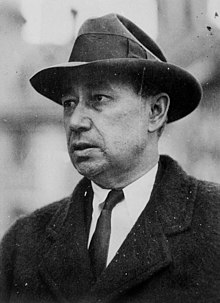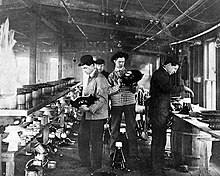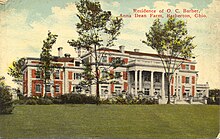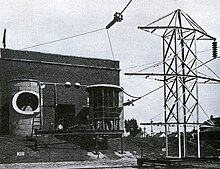
An electrical insulator is a material in which electric current does not flow freely. The atoms of the insulator have tightly bound electrons which cannot readily move. Other materials—semiconductors and conductors—conduct electric current more easily. The property that distinguishes an insulator is its resistivity; insulators have higher resistivity than semiconductors or conductors. The most common examples are non-metals.

In electrical engineering, ground or earth may be a reference point in an electrical circuit from which voltages are measured, a common return path for electric current, or a direct physical connection to the Earth.

A substation is a part of an electrical generation, transmission, and distribution system. Substations transform voltage from high to low, or the reverse, or perform any of several other important functions. Between the generating station and consumer, electric power may flow through several substations at different voltage levels. A substation may include transformers to change voltage levels between high transmission voltages and lower distribution voltages, or at the interconnection of two different transmission voltages. They are a common component of the infrastructure. There are 55,000 substations in the United States.

A lightning arrester is a device, essentially an air gap between an electric wire and ground, used on electric power transmission and telecommunication systems to protect the insulation and conductors of the system from the damaging effects of lightning. The typical lightning arrester has a high-voltage terminal and a ground terminal. When a lightning surge travels along the power line to the arrester, the current from the surge is diverted through the arrester, in most cases to earth.

A transmission tower is a tall structure, usually a lattice tower made of steel that is used to support an overhead power line. In electrical grids, transmission towers carry high-voltage transmission lines that transport bulk electric power from generating stations to electrical substations, from which electricity is delivered to end consumers; moreover, utility poles are used to support lower-voltage sub-transmission and distribution lines that transport electricity from substations to electricity customers.

In electronics, electrical breakdown or dielectric breakdown is a process that occurs when an electrically insulating material, subjected to a high enough voltage, suddenly becomes a conductor and current flows through it. All insulating materials undergo breakdown when the electric field caused by an applied voltage exceeds the material's dielectric strength. The voltage at which a given insulating object becomes conductive is called its breakdown voltage and, in addition to its dielectric strength, depends on its size and shape, and the location on the object at which the voltage is applied. Under sufficient voltage, electrical breakdown can occur within solids, liquids, or gases. However, the specific breakdown mechanisms are different for each kind of dielectric medium.

A guy-wire, guy-line, guy-rope, down guy, or stay, also called simply a guy, is a tensioned cable designed to add stability to a freestanding structure. They are used commonly for ship masts, radio masts, wind turbines, utility poles, and tents. A thin vertical mast supported by guy wires is called a guyed mast. Structures that support antennas are frequently of a lattice construction and are called "towers". One end of the guy is attached to the structure, and the other is anchored to the ground at some distance from the mast or tower base. The tension in the diagonal guy-wire, combined with the compression and buckling strength of the structure, allows the structure to withstand lateral loads such as wind or the weight of cantilevered structures. They are installed radially, usually at equal angles about the structure, in trios and quads. As the tower leans a bit due to the wind force, the increased guy tension is resolved into a compression force in the tower or mast and a lateral force that resists the wind load. For example, antenna masts are often held up by three guy-wires at 120° angles. Structures with predictable lateral loads, such as electrical utility poles, may require only a single guy-wire to offset the lateral pull of the electrical wires, at a spot where the wires change direction.

An HVDC converter station is a specialised type of substation which forms the terminal equipment for a high-voltage direct current (HVDC) transmission line. It converts direct current to alternating current or the reverse. In addition to the converter, the station usually contains:

A utility pole is a column or post, usually made out of wood or aluminum alloy, used to support overhead power lines and various other public utilities, such as electrical cable, fiber optic cable, and related equipment such as transformers and street lights. It can be referred to as a transmission pole, telephone pole, telecommunication pole, power pole, hydro pole, telegraph pole, or telegraph post, depending on its application. A Stobie pole is a multi-purpose pole made of two steel joists held apart by a slab of concrete in the middle, generally found in South Australia.

An overhead power line is a structure used in electric power transmission and distribution to transmit electrical energy along large distances. It consists of one or more conductors suspended by towers or poles. Since the surrounding air provides good cooling, insulation along long passages and allows optical inspection, overhead power lines are generally the lowest-cost method of power transmission for large quantities of electric energy.

A mast radiator is a radio mast or tower in which the metal structure itself is energized and functions as an antenna. This design, first used widely in the 1930s, is commonly used for transmitting antennas operating at low frequencies, in the LF and MF bands, in particular those used for AM radio broadcasting stations. The conductive steel mast is electrically connected to the transmitter. Its base is usually mounted on a nonconductive support to insulate it from the ground. A mast radiator is a form of monopole antenna.

WHK is a commercial AM radio station licensed to Cleveland, Ohio, carrying a talk format known as "AM 1420 The Answer". Owned by the Salem Media Group, the station serves both Greater Cleveland and the Northeast Ohio region as an affiliate for the Salem Radio Network. WHK's studios are currently located in the Cleveland suburb of Independence while the transmitter site resides in neighboring Seven Hills.

WKDD is a commercial radio station licensed to Munroe Falls, Ohio, United States, featuring a hot adult contemporary format known as "98.1 KDD". Owned by iHeartMedia, Inc., the station serves both the Akron-Canton metro area, with additional coverage in Greater Cleveland and much of surrounding Northeast Ohio. WKDD's studios are located in North Canton, while the transmitter is located in Cuyahoga Falls. In addition to a standard analog transmission, WKDD broadcasts over two HD Radio channels, and streams online via iHeartRadio.

Arcing horns are projecting conductors used to protect insulators or switch hardware on high voltage electric power transmission systems from damage during flashover. Overvoltages on transmission lines, due to atmospheric electricity, lightning strikes, or electrical faults, can cause arcs across insulators (flashovers) that can damage them. Alternately, atmospheric conditions or transients that occur during switching can cause an arc to form in the breaking path of a switch during its operation. Arcing horns provide a path for flashover to occur that bypasses the surface of the protected device. Horns are normally paired on either side of an insulator, one connected to the high voltage part and the other to ground, or at the breaking point of a switch contact. They are frequently to be seen on insulator strings on overhead lines, or protecting transformer bushings.

A strain insulator is an electrical insulator that is designed to work in mechanical tension (strain), to withstand the pull of a suspended electrical wire or cable. They are used in overhead electrical wiring, to support radio antennas and overhead power lines. A strain insulator may be inserted between two lengths of wire to isolate them electrically from each other while maintaining a mechanical connection, or where a wire attaches to a pole or tower, to transmit the pull of the wire to the support while insulating it electrically. Strain insulators were first used in telegraph systems in the mid 19th century.
China XD Group is a Chinese state-owned power engineering company and manufacturer of electrical equipment. The company was established in July 1959 and was formerly known as Xi'an Electric Machinery Manufacturing Company, it was also known as Xi'an XD, Xi'an Xidian, and Xi'an Electric

An Austin ring transformer is a special type of isolation transformer with low capacitance between the primary and secondary windings and high isolation.

Nikola Tesla patented the Tesla coil circuit on April 25, 1891. and first publicly demonstrated it May 20, 1891 in his lecture "Experiments with Alternate Currents of Very High Frequency and Their Application to Methods of Artificial Illumination" before the American Institute of Electrical Engineers at Columbia College, New York. Although Tesla patented many similar circuits during this period, this was the first that contained all the elements of the Tesla coil: high voltage primary transformer, capacitor, spark gap, and air core "oscillation transformer".
Louis Dijour Smullin was an American electrical engineer who spend most of his career at the Massachusetts Institute of Technology (MIT). He is best known for his work with Giorgio Fiocco to measure the distance to the Moon using a ruby laser in 1962, shortly after that device was invented. Earlier, he had worked in the microwave radar field at the MIT Radiation Laboratory and was instrumental in creating the Lincoln Laboratory that carried on this work. Later he worked on developing instrumentation for nuclear fusion research and many other projects. He retired in 1986 but worked in the department until 2001.























